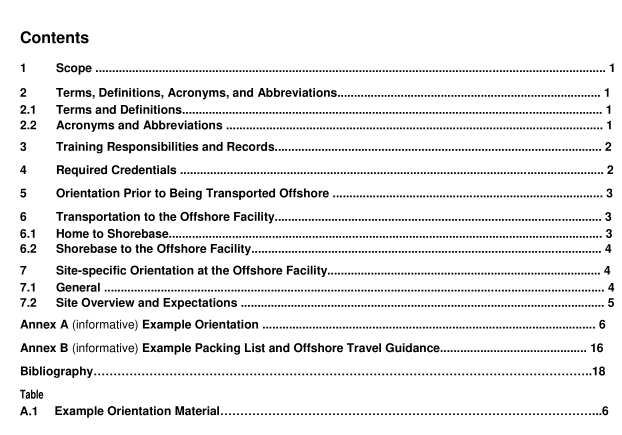API RP T-1 pdf download

API RP T-1 pdf download Creating Orientation Programs for Personnel Going Offshore
3 Training Responsibilities and Records
Employers are responsible for training their employees.Documentation of training shall be maintained foremployees.Training topics are dependent on worker duties and regulations applicable to the facility
location. Prior to the employee’s assignment, the employer shall evaluate training needs, including as aminimum each of topics below, and communicate to each employee whether these topics or additionaltopics are required:
a) hazard communication(HAZCOM) and Globally Harmonized System of Classification and Labelling
of Chemicals (GHS);
b) Helicopter Underwater Egress Training (HUET) and offshore water survival;c) Safety and Environmental Management System (SEMS) training;
dmarine trash and debris (as described in BSEE NTL No.2012-G01);
e) job-specific training, skills,and knowledge verification including, but not limited to
—API 2D rigger training,
— API 2D crane operator training,—NFPA 70E,
— fall protection,- hot work,
-respiratory protection,
—confined space entry and attendant, and- hazardous energy control, lock-out’tag-out.4 Required Credentials
The employer shall be responsible for ensuring that the employee has required credentials in his or herpossession. Some examples of required credentials are as follows.
a)Government-issued photo ID is required for all helicopter transportation.
b)Transportation Worker ldentification Credential (TWIC) card is required for certain facilities.
c)Other credentials can be required based on the facility, operator, and job classification such as the following:
—— crane operator and rigger certification based on API 2D,
— HUET and water survival card,
— certain medical clearance credentials depending on origination of travel,
— industry-specific offshore orientation.
5 Orientation Prior to Being Transported Offshore
Before personnel are sent offshore for the first time, the employer shall provide an orientation to personnel that includes but is not limited to the following topics:
a) the jobs, tasks, and activities prohibited for untrained offshore workers;
b) working conditions—length of hitch, typical work day, materials to bring, meals, laundry options;
c) transportation from the worker’s home to the offshore facility as indicated in Section 6;
d) marine trash and debris training;
e) environmental awareness—deck drains, sumps, hydrocarbon containment;
f) check-in procedures at offshore facilities;
g) hazard recognition, to include
— platform movement and associated risks in doorways and on stairway travel,
— handrail movement,
— weather issues,
— hazards of cranes and suspended loads, and
— working at perceived heights and on open grating over water;
h) security and maritime security (MARSEC);
i)tobacco use, smoking, e-cigarettes, including designated smoking areas;
first aid resources and rules for handling personal medications;
k) personal protective equipment (PPE).
See Annex A for an example of orientation material.
6 Transportation to the Offshore Facility
6.1
Home to Shorebase
Employees should be prepared to live at the offshore facility for the duration of their hitch. Trip guidance shall be provided to the employee that includes transportation directions, parking instructions if applicable, expected duration of the hitch, and a suggested packing list. An example packing list can be found in Annex B.
The employer shall inform all personnel of the expectation to be prepared to work when the workers arrive at the shorebase, including approved clothing and footwear. This means they should be rested and









